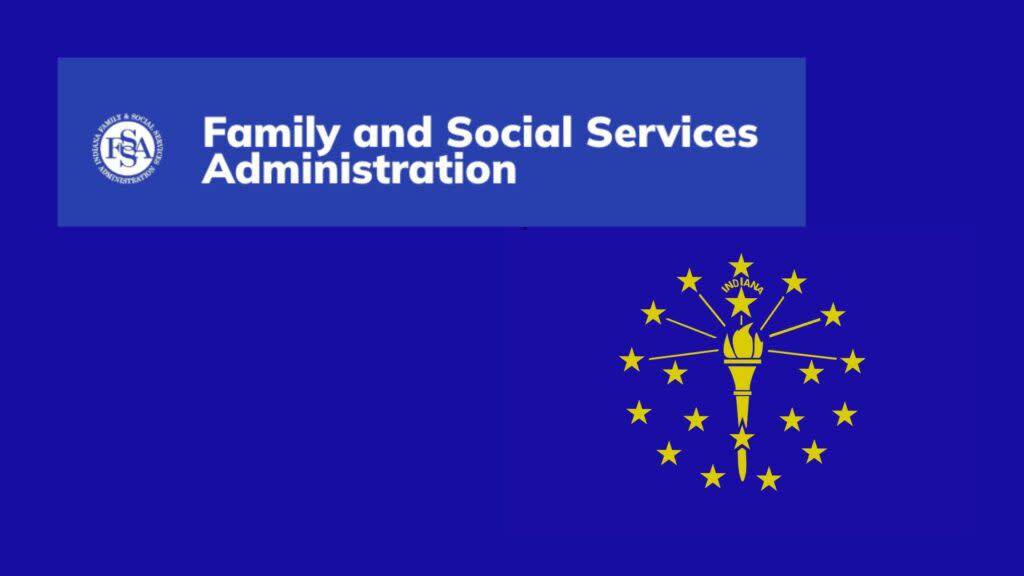FSSA launches monthly Medicaid reports detailing enrollment, expenses and funding

The Family and Social Services Administration will now release monthly finance reports detailing enrollment, expenses and funding to the public. (Logo, flag from FSSA and State of Indiana)
In the wake of a Medicaid budget snafu, in which a forecast missed the mark by nearly $1 billion, the Family and Social Services Administration has launched monthly Medicaid finance reports detailing expenditures, enrollment and funding of the entitlement program.
The move comes after lawmakers mandated additional monitoring and oversight.
In a release, the FSSA Office of Medicaid Policy and Planning said the webpage provides “transparency and information” on the program. Additionally, the report compares the “actual monthly experience” with previous predications.
“As of February 2024, Medicaid enrollment across all programs and delivery systems totaled 1,999,726 individuals, which is 26,746 (1.3%) above the forecasted amount and 74,294 (3.4%) below enrollment in February 2023,” the accompanying commentary read. “Average monthly enrollment year-to-date for (fiscal year) 2024 through February was 2,101,668.”
In response to the $1 billion “variance,” FSSA announced it would pursue several program changes to recoup an estimated $300 million in costs, such as pausing an “index,” or increase, in certain reimbursements.
But the biggest change included curbing payments to legally responsible individuals, usually parents, under attendant care for medically complex children. Parents rallied for weeks but saw little in terms of legislation.
Recently, families met with Gov. Eric Holcomb and FSSA Secretary Dan Rusyniak to discuss the transition to Structured Family Caregiving. Click here to read the latest development.
The Indiana Capital Chronicle explored ongoing challenges with Medicaid budgets in February, focusing on the difficulties that came from predicting long-term expenses for an ever-growing fund. Budget experts suggested monthly reports as one way to better keep the public informed.
According to an attached explainer, expenditures include amounts spent on specific programs while funding includes both federal and state revenue streams — including intergovernmental transfers and assessment fees — and how much has been spent out of each funding source. Enrollment numbers will include a breakdown by Medicaid program.
Notably, year-to-date figures start from the beginning of the state’s fiscal year, July 1, and not the calendar year.
The report shows just how many Hoosiers have been determined ineligible and lost coverage during an “unwinding” period when Medicaid programs returned to a pre-pandemic level of operations. During COVID-19, the federal government agreed to shoulder an additional percentage of costs as an incentive for states not to curb Medicaid enrollment. Indiana’s rolls ballooned to a high of nearly 2.3 million in April 2023 compared to 1.6 million in April of 2020.
In April, the state agency started a review process of all enrollees. Since that time, roughly 371,000 individuals were disenrolled — though the commentary notes that 20-25% of those who lost coverage were re-enrolled within 90 days after submitting additional information.
In terms of expenditures, expenses are $102 million above the December 2023 forecast and $1.7 billion above expenditures from February of 2023 — the latter is partially due to the loss of that federal enhancement. Some of these costs are not borne by the state’s general fund, but rather a portion of the state cigarette tax, hospital assessment fees and other sources.
Partly due to factors like the above, the Medicaid Assistance Fund’s draw on the general fund is actually below projections by $22 million, or 0.81%, for a total of $2.7 billion. Federal funds make up approximately 71% of overall funding for Medicaid, followed by 20% from the general fund and 9% from other sources.
The reports also detail expenses for the transition of Medicaid from a fee-for-service program, in which the state reimburses providers for individual costs, to a managed care program, where FSSA pays a bulk rate per enrollee and managed care entities handle individual costs.
The post FSSA launches monthly Medicaid reports detailing enrollment, expenses and funding appeared first on Indiana Capital Chronicle.

